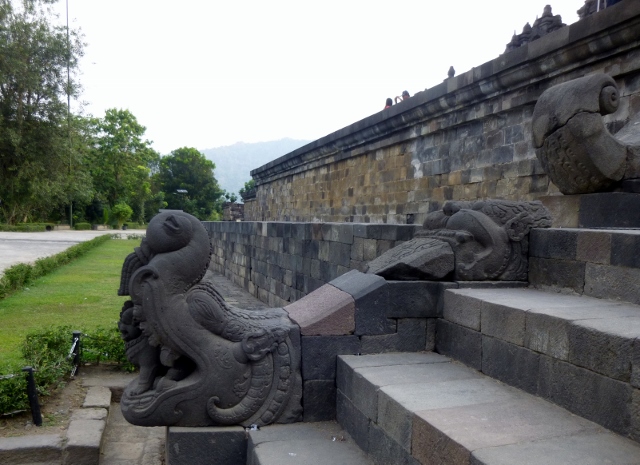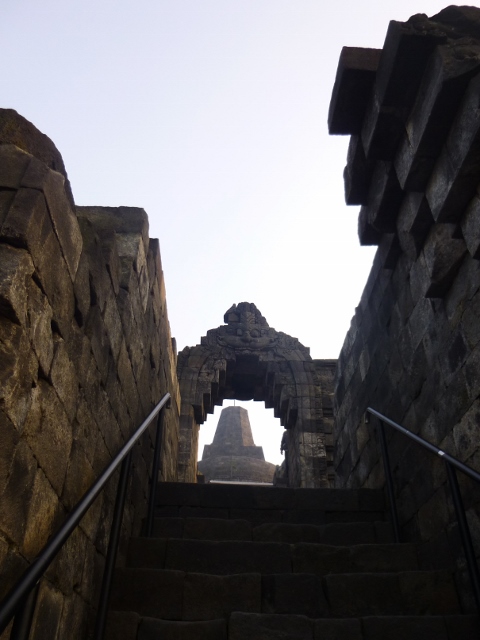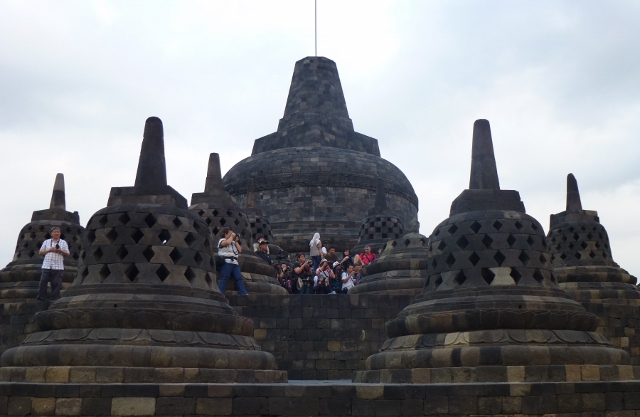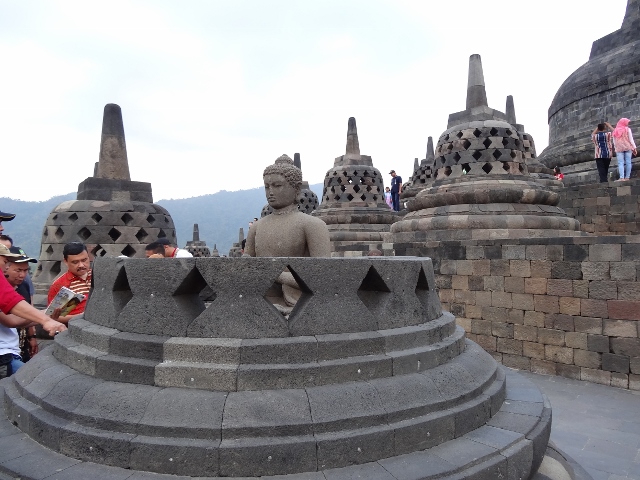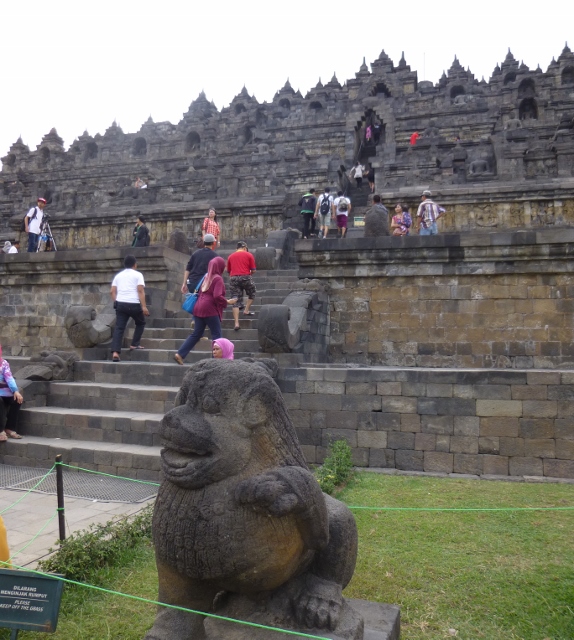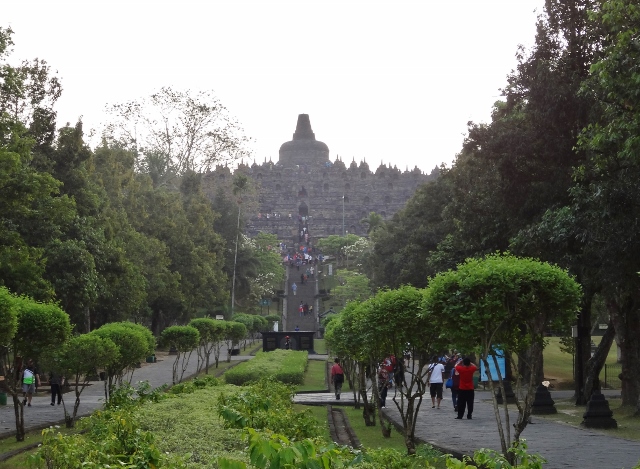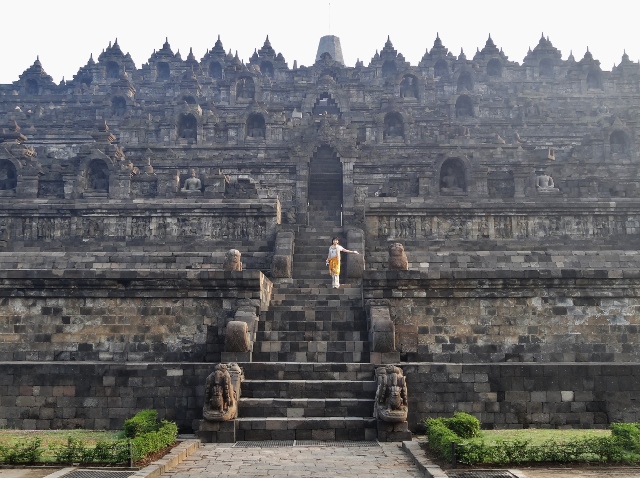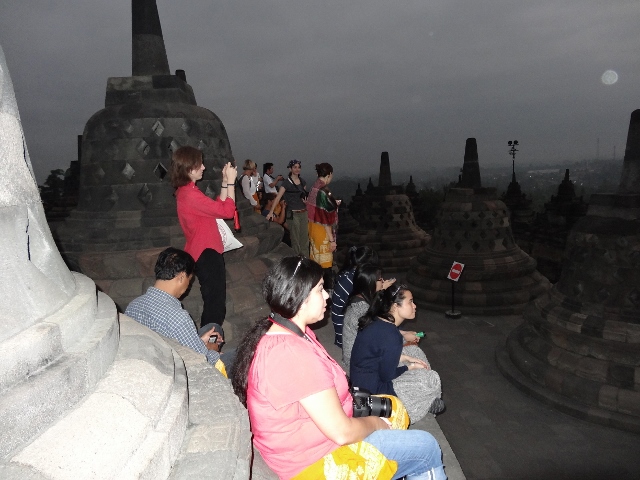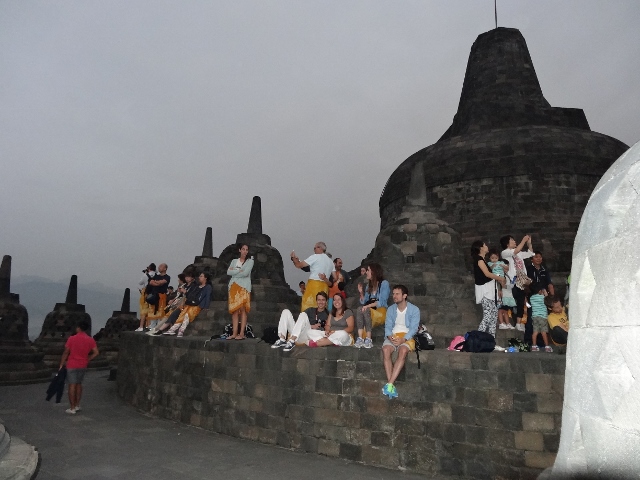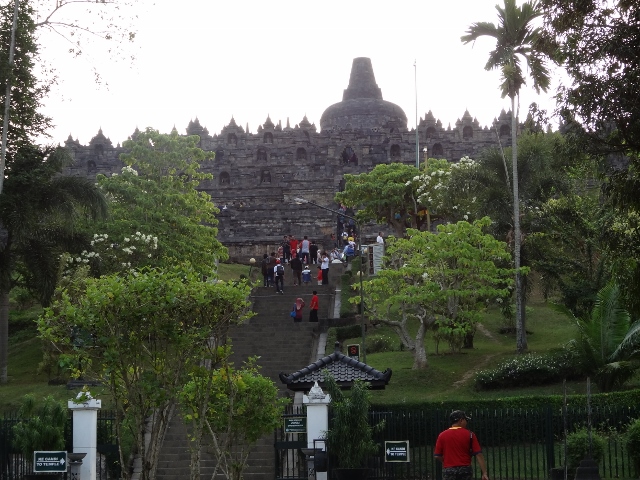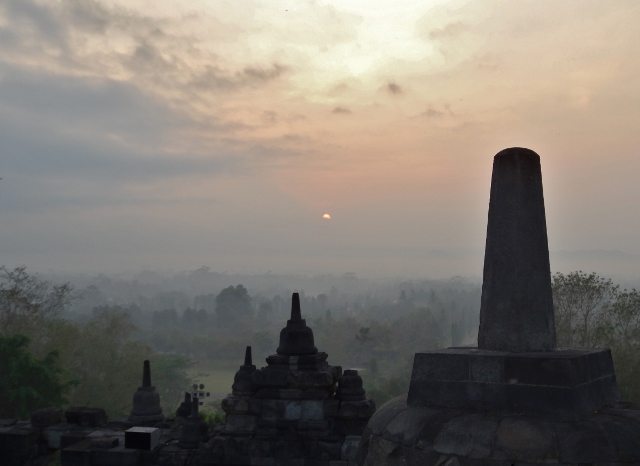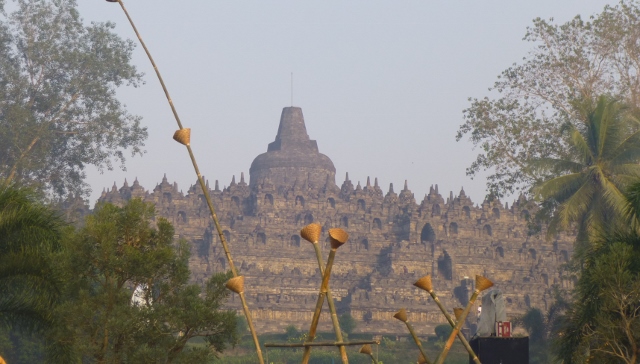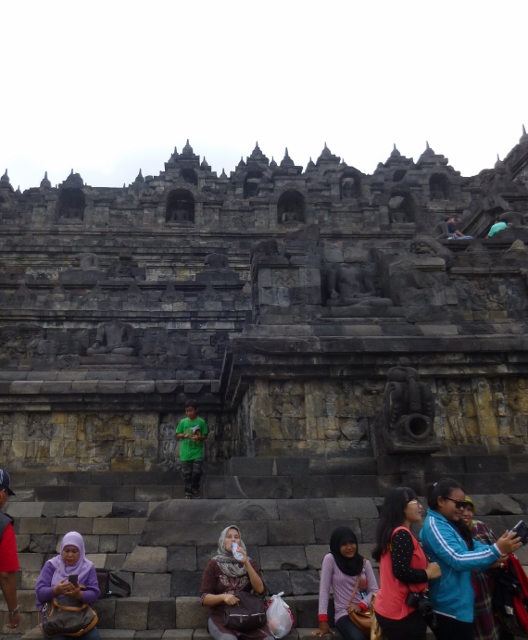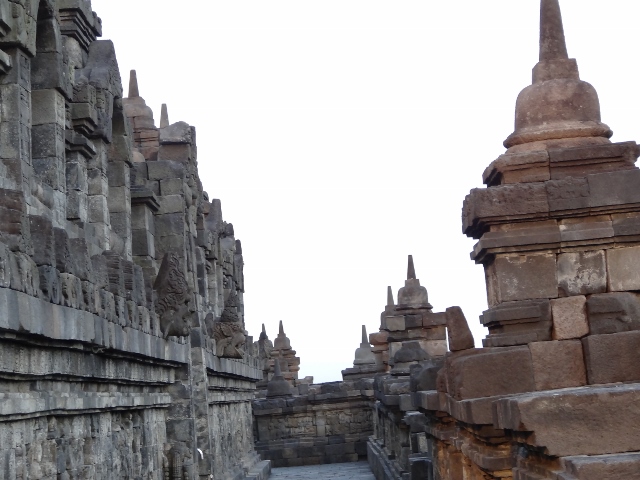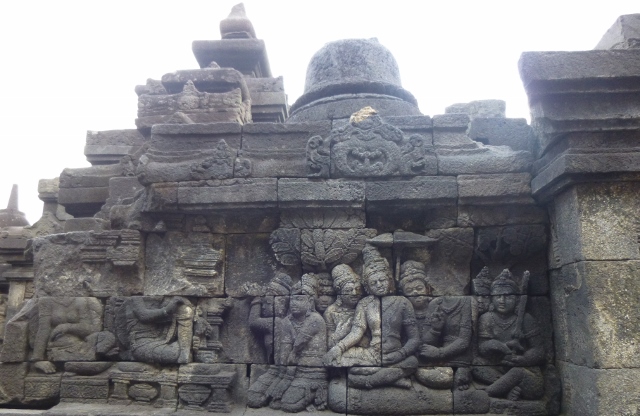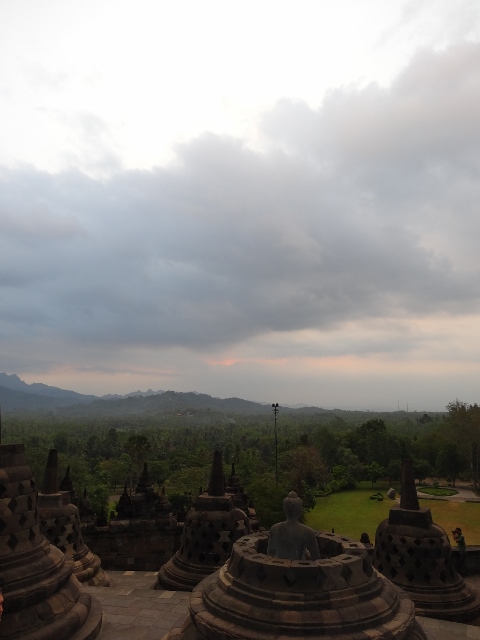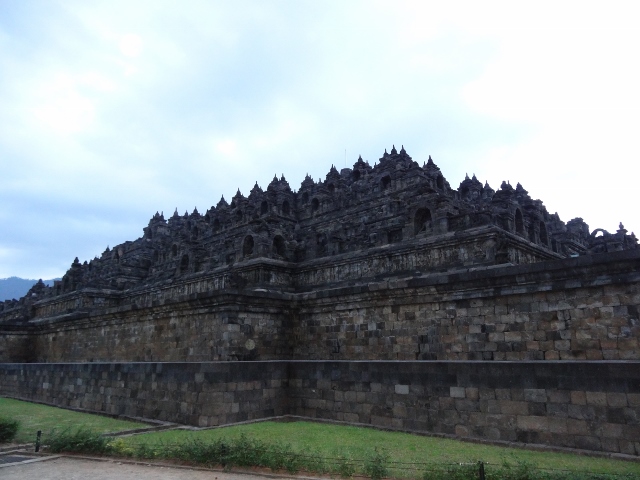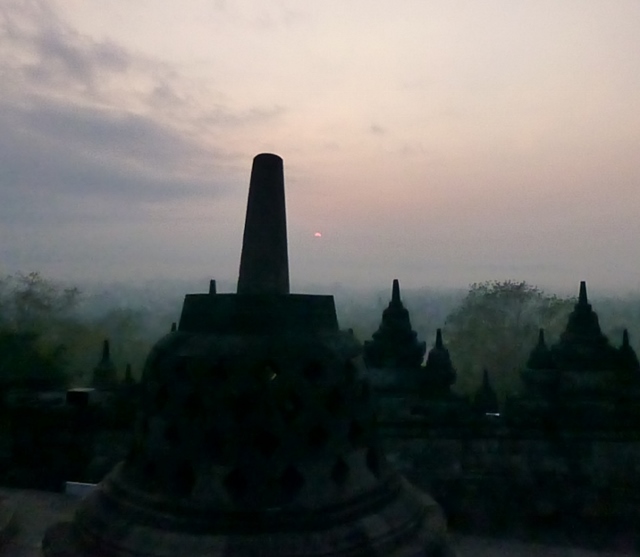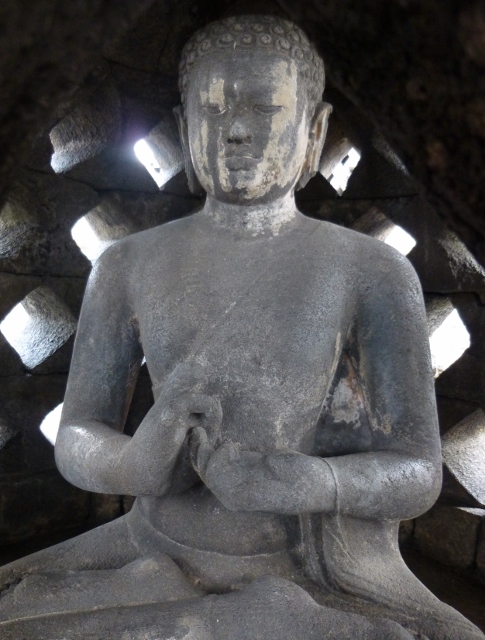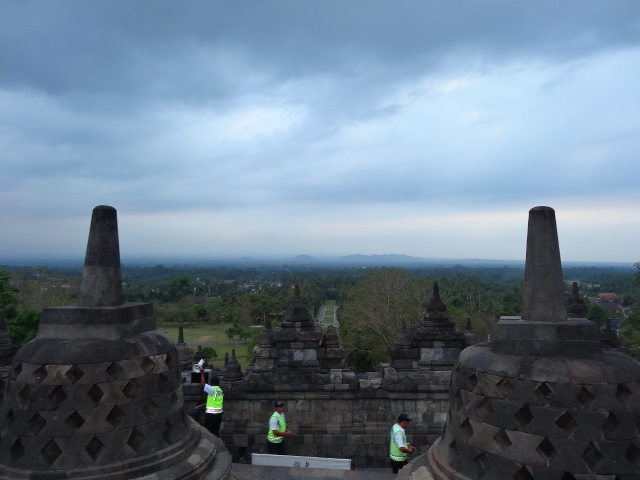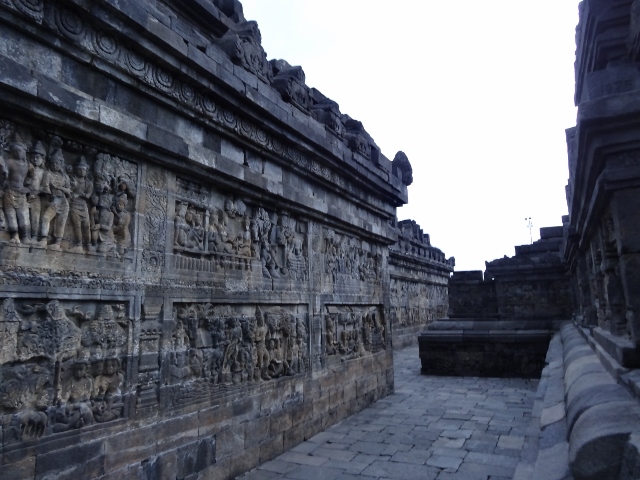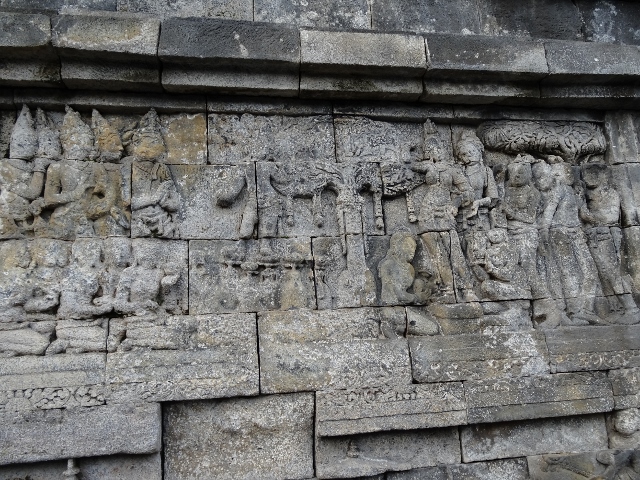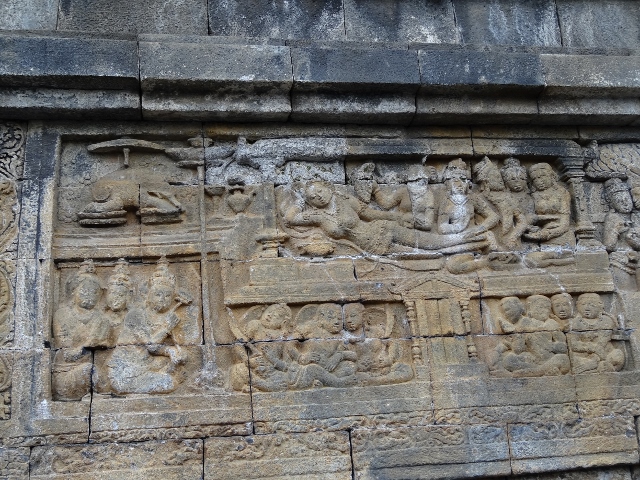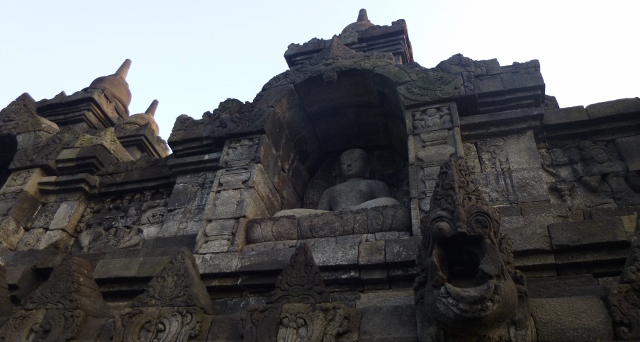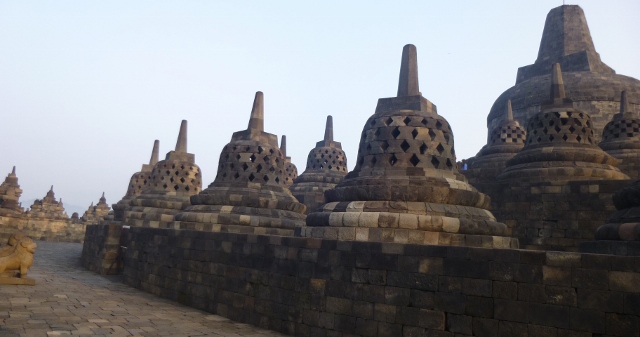Borobudur is a 9th-century Mahayana Buddhist Temple in Central Java, Indonesia.
*Mahayana=マハヤーナ=大乗仏教
Built from the 8th to 9th century (780AD-833AD, the era of Kuukai in
Japan) during the reign of the Sailendra Dynasty, the temple was designed in Javanese Buddhist architecture, which blends the Indonesian indigenous cult of ancestor worship and the Buddhist concept of attaining Nirvana.
*indigenous=インディジナス=固有の、現地の *cult=カルトゥ=宗派 *Nirvana=ニアばナァ=涅槃(ねはん)、解脱
Worldwide knowledge of its existence was sparked in 1814 by Sir Thomas Stamford Raffles, then the British ruler of Java, who was advised of its location by native
Indonesians.
Borobudur has since been preserved through several restorations. The largest restoration project was undertaken between 1975 and 1982 by the Indonesian government
and UNESCO, following which the monument was listed as a UNESCO World Heritage Site.
The monument consists of six square platforms topped by three circular
platforms and is decorated with 2,672 relief panels and 504 Buddha statues.
*restoration=復興、修復 *platfrom=壇
*World Heritae Site=世界遺産・・・Siteがあると、広範囲、 heritage=文化遺産、相続財産、site=遺跡、敷地
A main dome, located at the center of the top platform, is surrounded
by 72 Buddha statues seated inside a perforated stupa. It is the world’s largest Buddhist temple as well as one of the greatest
Buddhist monuments in the world.
*perforated=パーふォレイティッドゥ=複数個の穴の開いた、(切手など)ミシン目のある
*stupa=ストゥーパ=(ドーム型の)仏舎利塔
The monument is both a shrine to the Lord Buddha and a place for Buddhist pilgrimage. The journey for pilgrims begins at the base of the monument and follows a path around the monument and ascends to the top through three levels symbolic of Buddhist cosmology: Kāmadhātu (the world of desire), Rupadhatu (the world of forms) and Arupadhatu (the world of formlessness). The monument guides pilgrims through an extensive system of stairways and corridors with 1,460 narrative relief panels on the walls and the balustrades. Borobudur has the largest and most complete ensemble of Buddhist reliefs in the world.[4]
On 21 January 1985, nine stupas were badly damaged by nine bombs. In 1991, a blind Muslim preacher, Husein Ali Al Habsyie, was sentenced
to life imprisonment for masterminding a series of bombings in the mid-1980s, including the temple attack.
In 2006, an earthquake of 6.2 magnitude on the Richter scale struck the south coast of Central Java. The event caused severe damage around the region and casualties to the nearby city of Yogyakarta, but Borobudur remained intact
*intact=インタクトゥ=無傷の=undermaged
Borobudur was heavily affected by the eruption of Mount Merapi in 2010. Volcanic ash from Merapi fell on the temple complex, which is
approximately 28 kilometres west-southwest of the crater. A layer of ash
up to 2.5 centimetres fell on the temple statues. The temple complex was
closed from 5 to 9 November to clean up the ashfall.
Borobudur is still used for pilgrimage; once a year, Buddhists in Indonesia
celebrate Vesak at the monument, and Borobudur is Indonesia's single most visited tourist attraction.
ボロブドゥール寺院
ボロブドゥール遺跡は、インドネシアのジャワ島中部(ジョグジャカルタの北西約42km)のケドゥ盆地に所在する、世界的な大乗仏教の石造遺跡です。
8世紀から9世紀 (780AD-833AD、日本では空海の時代) のシャイレーンドラ朝の時代に建造されましたが、19世紀初め、イギリス人福総監ラッフルズによって発見されるまで、ジャワの密林に千年以上も埋もれていたということです。原因は、火山の降灰によるものであるとする説と、イスラム教徒による破壊をおそれて人びとが埋めたという説があるようです。
東には、今も噴火を続けるムラピ火山(Gunung Merapi、2930m)があり、遺跡総面積はおよそ1.5万m2(1辺が120mくらい)。高さはもともと42mあったが、現在は破損して33.5mになっている。
仏教的宇宙感を立体の曼荼羅によって表したもので、9層に積み上げられ、最下層が欲望界、上にいくにつれ色界、無色界、そして最上層は天上界を意味しているとのこと。
総延長5kmにおよぶ方形壇の回廊の壁には、大乗仏教の教えに基づく釈迦誕生図などの物語にもとづいた1460面におよぶレリーフが時計回りにつづいている。
、大乗仏教を奉じていたシャイレーンドラ王家によって、ダルマトゥンガ王治下の780年頃から建造が開始され、792年頃に一応の完成をみたと考えられるが、サマラトゥンガ王(位812年~832年)のときに増築されている。
ボロブドゥールは、寺院として人びとに信仰されてきた建造物であるが、内部空間を持たないのが際だった特徴となっている。最も下に一辺約120mの基壇があり、その上に5層の方形壇、さらにその上に3層の円形壇があり、全体で9層の階段ピラミッド状の構造となっている。この構造は、仏教の三界 (欲界・色界・無色界)をあらわしているとされる。
5層の方形壇の縁は壁になっていて、露天の回廊がめぐらされる。方形壇の四面中央には階段が設けられており、円形壇まで登れるようになっている。
仏像は、回廊の壁龕(くぼみ)に432体、3段の円形壇の上に築かれた釣鐘状のストゥーパ72基の内部に1体ずつ納められており、合計では504体ある。
レリーフは、その構図の巧みさ、洗練された浮き彫り彫刻の技法、細部表現の優雅さで知られ、仏像とともにインドのグプタ様式の影響が強く認められるとされる。
ボロブドゥールはまた、その形状から世界最大級のストゥーパ(仏塔)でもある。
ストゥーパとは、釈迦の遺骨や遺物などをおさめた建造物であるが、ボロブドゥールは、さらにその内部にも多数のストゥーパを有する特異な構造を呈している。
(ただし、頂上部のストゥーパからは現在までに何も発見されていない)
The three temples[edit]

Straight-line arrangement of Borobudur, Pawon, and Mendut
Approximately 40 kilometres (25 mi) northwest of Yogyakarta and 86 kilometres (53 mi) west of Surakarta, Borobudur is located in an elevated area between two twin volcanoes, Sundoro-Sumbing and Merbabu-Merapi, and two rivers, the Progo and the Elo. According to local myth, the area known as Kedu Plain is a Javanese "sacred" place and has been dubbed "the garden of Java" due to its high agricultural fertility.[18] During the restoration in the early 20th century, it was discovered that three Buddhist temples in the region, Borobudur, Pawon and Mendut, are positioned along a straight line.[19] A ritual relationship between the three temples must have existed, although the exact ritual process is unknown.[13]
↙各ストゥーパの中には、仏像が収められています。唯一、露出した仏像を囲う石に、埋め込まれた白いビスが見えますか?↗ これは修復した印とのこと。これ以上の修復は世界遺産認定取り消しとなるため、行われていないとのことです。
外国人向けサンセット(夕日見学?)入場料は380,000ルピア(日本円で約3,800円)。特別入場料を払っている人以外は、警備員に締め出されてしまいます。あいにく、夕日は見えませんでしたが・・・↓
Indonesia (インドネシア) Borbobudur
朝5時15分頃から日出を待ちました。あいにくガスっていたのですが、日出前から小鳥たちがさえずり始め、多くの人々が、ワクワクとその瞬間を待ちます。↑
午前6時ごろ、メラピ山の稜線から、朝日が少しずつ顔を出し始めました。ボロブドゥールから見る朝日・・・・とても幻想的でした。→
←寺院参拝と言うことで、肌露出は控えるようになっています。今回は、ボロブドゥールから歩いて10分ほどのホテルに宿泊し、サロン(腰巻用の布)が、日出を見るツアー参加者全員に、無料で貸し出されました。
世界的に知られる美しい仏像に心が安らぐ仏教寺院
ボロブドゥール遺跡から東へ約3kmの場所にある「ムンドゥッ寺院」は、堂内に安置された3体の石像仏がジャワ美術の真髄とされる有名な仏教寺院です。特に、高さ3mもある中央の如来倚座像はその美しさで知られており、優しげな表情が見る者の心を癒します。また、寺院の内壁や外壁に描かれた鬼子母神や毘沙門天のレリーフも素晴らしく、一見の価値ありです。
回廊の壁ビッシリと彫られたレリーフの数に圧倒されます。千年以上昔の物とは思えません。


